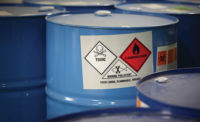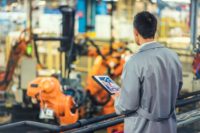How to implement automation with worker safety in mind

More manufacturers are turning to automation amid ongoing labor shortages and pressure to maximize productivity. While it has many advantages, these machines can pose risks if manufacturers are not careful. Businesses must implement automation with worker safety in mind to capitalize on it fully.
Perform a risk assessment
Manufacturers should start by understanding their unique workplace hazards and any new ones automation may introduce. That means compiling a formal list of these risks and assigning each a score based on their likelihood and severity.
OSHA cites failure to identify hazards as one of the root causes of workplace injuries. Performing a detailed risk assessment will inform safer automation by showing where robots may improve workplace safety and where they may threaten it. This insight is critical to taking effective corrective measures.
Consider how automation may improve safety
With this hazard assessment in hand, manufacturers can find areas to boost safety through automation. Automation can reduce manufacturing injuries by up to 72% under the right circumstances, often by performing the most dangerous processes so humans do not need to. Consequently, manufacturers should aim to automate these workflows first.
Use the risk assessment to find the facility’s most dangerous workflows. Compare these to automation’s skillset — generally, anything highly repetitive or intensely physical. Processes that fall into both categories are ideal starting points for automation.
Automate slowly and carefully
Once manufacturers decide on an appropriate automation solution, they should approach it with care. Robotic solutions are expensive and often initially disruptive to implement, so a rushed process can create higher-than-expected losses and pose unnecessary risks.
Start by automating one process or workflow, then carefully observe all results. Record what workplace safety factors improve as well as any new incidents that occur. These documents will help inform a safer, more effective rollout when adding more automation into the facility.
Create safety barriers
As businesses automate more workflows, they should place barriers between robotic systems and human employees. Because these machines often work at high speeds, include many moving parts and may involve heavy components, they can produce many physical risks to nearby workers. Their high power may also pose hazards, as even low-voltage equipment can cause arrhythmia or heart attacks if the currents run through workers’ hearts.
The safest way to approach these hazards is to create physical barriers between hazardous machines and workers. On top of physical stopgaps, manufacturers should implement protections like emergency shutoff switches and lockout/tagout procedures.
Maintain automated equipment
Maintenance is another crucial step in reducing robot-related hazards. Regular maintenance prevents equipment failures that cause injuries or introduce new risks. Similarly, it will reduce the chances of errors that disrupt workers and cause unnecessary stress, heightening other hazards.
Regular preventive checks and repairs based on OEM’s recommendations are an excellent place to start for most machines. For more sensitive or mission-critical equipment, manufacturers should enable predictive maintenance. This approach uses sensors to alert workers when a machine needs repair, dramatically reducing downtime and error prevention.
Train workers thoroughly
Finally, manufacturers should ensure their workforce is ready for the new, automated workflow. Businesses should train employees thoroughly on how to work with and around these machines. This training should begin before implementing any robotics so workers are ready for the shift.
Thorough, early training will minimize the risks of the new system disrupting or distracting workers. Because almost all workplace incidents involve human error, this preparation will yield substantial safety improvements.
Automation can improve safety with the right approach
A reckless approach to automation can endanger workers, but thoughtful, careful automation will have the opposite effect. If manufacturers can understand this technology’s impact on workplace safety and implement it accordingly, they can use it to reduce accidents.
Following these steps will help manufacturers embrace automation while minimizing safety-related risks. They can then make the most of what this technology has to offerLooking for a reprint of this article?
From high-res PDFs to custom plaques, order your copy today!





